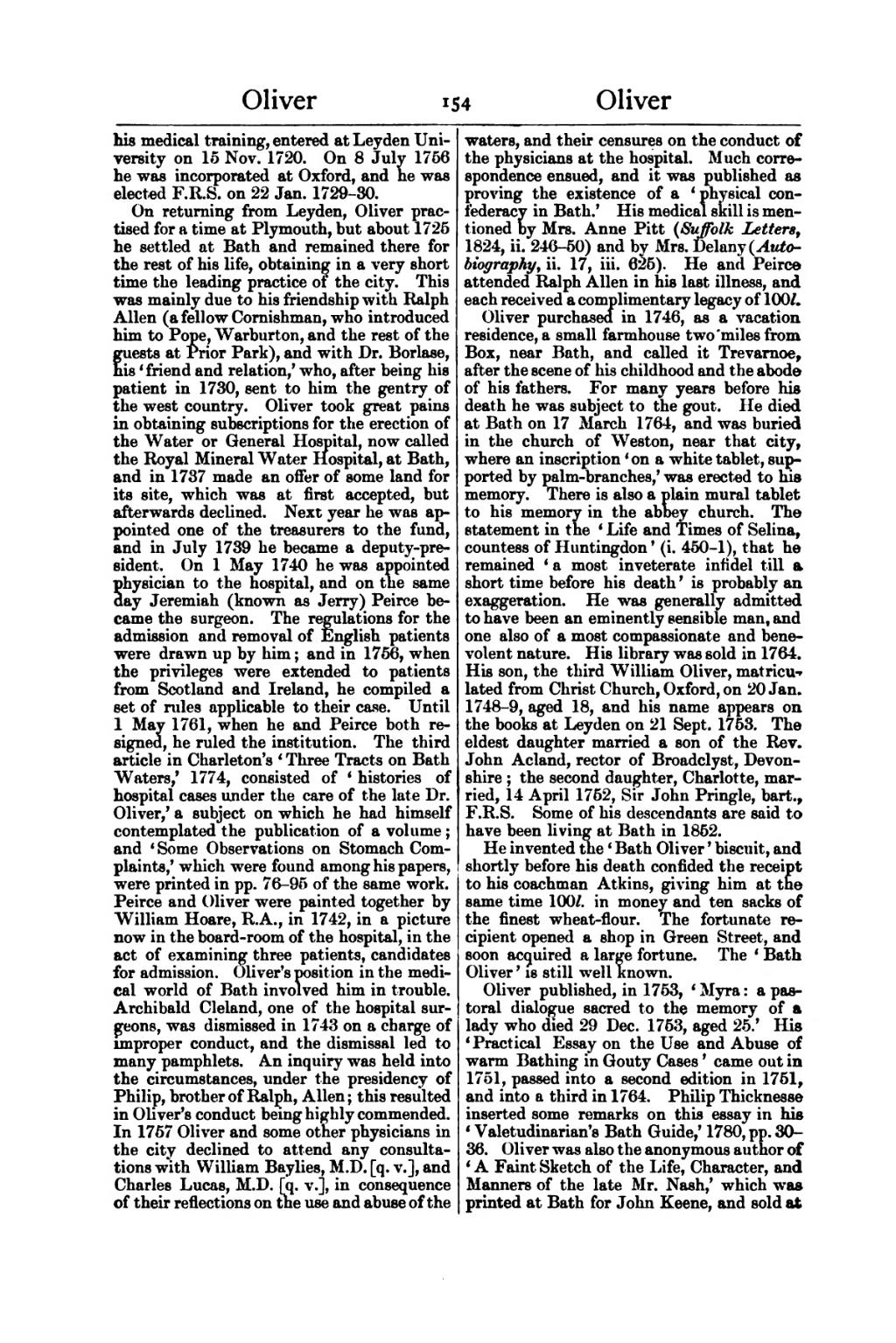his medical training, entered at Leyden University on 15 Nov. 1720. On 8 July 1756 he was incorporated at Oxford, and he was elected F.R.S. on 22 Jan. 1729–30.
On returning from Leyden, Oliver practised for a time at Plymouth, but about 1725 he settled at Bath and remained there for the rest of his life, obtaining in a very short time the leading practice of the city. This was mainly due to his friendship with Ralph Allen (a fellow Cornishman, who introduced him to Pope, Warburton, and the rest of the guests at Prior Park), and with Dr. Borlase, his ‘friend and relation,’ who, after being his patient in 1730, sent to him the gentry of the west country. Oliver took great pains in obtaining subscriptions for the erection of the Water or General Hospital, now called the Royal Mineral Water Hospital, at Bath, and in 1737 made an offer of some land for its site, which was at first accepted, but afterwards declined. Next year he was appointed one of the treasurers to the fund, and in July 1739 he became a deputy-president. On 1 May 1740 he was appointed physician to the hospital, and on the same day Jeremiah (known as Jerry) Peirce became the surgeon. The regulations for the admission and removal of English patients were drawn up by him; and in 1756, when the privileges were extended to patients from Scotland and Ireland, he compiled a set of rules applicable to their case. Until 1 May 1761, when he and Peirce both resigned, he ruled the institution. The third article in Charleton's ‘Three Tracts on Bath Waters,’ 1774, consisted of ‘histories of hospital cases under the care of the late Dr. Oliver,’ a subject on which he had himself contemplated the publication of a volume; and ‘Some Observations on Stomach Complaints,’ which were found among his papers, were printed in pp. 76–95 of the same work. Peirce and Oliver were painted together by William Hoare, R.A., in 1742, in a picture now in the board-room of the hospital, in the act of examining three patients, candidates for admission. Oliver's position in the medical world of Bath involved him in trouble. Archibald Cleland, one of the hospital surgeons, was dismissed in 1743 on a charge of improper conduct, and the dismissal led to many pamphlets. An inquiry was held into the circumstances, under the presidency of Philip, brother of Ralph, Allen; this resulted in Oliver's conduct being highly commended. In 1757 Oliver and some other physicians in the city declined to attend any consultations with Baylies, William, M.D. [q. v.], and Lucas, Charles (1713-1771), M.D. [q. v.], in consequence of their reflections on the use and abuse of the waters, and their censures on the conduct of the physicians at the hospital. Much correspondence ensued, and it was published as proving the existence of a ‘physical confederacy in Bath.’ His medical skill is mentioned by Mrs. Anne Pitt (Suffolk Letters, 1824, ii. 246–50) and by Mrs. Delany (Autobiography, ii. 17, iii. 625). He and Peirce attended Ralph Allen in his last illness, and each received a complimentary legacy of 100l.
Oliver purchased in 1746, as a vacation residence, a small farmhouse two miles from Box, near Bath, and called it Trevarnoe, after the scene of his childhood and the abode of his fathers. For many years before his death he was subject to the gout. He died at Bath on 17 March 1764, and was buried in the church of Weston, near that city, where an inscription ‘on a white tablet, supported by palm-branches,’ was erected to his memory. There is also a plain mural tablet to his memory in the abbey church. The statement in the ‘Life and Times of Selina, countess of Huntingdon’ (i. 450–1), that he remained ‘a most inveterate infidel till a short time before his death’ is probably an exaggeration. He was generally admitted to have been an eminently sensible man, and one also of a most compassionate and benevolent nature. His library was sold in 1764. His son, the third William Oliver, matriculated from Christ Church, Oxford, on 20 Jan. 1748–9, aged 18, and his name appears on the books at Leyden on 21 Sept. 1753. The eldest daughter married a son of the Rev. John Acland, rector of Broadclyst, Devonshire; the second daughter, Charlotte, married, 14 April 1752, Sir John Pringle, bart., F.R.S. Some of his descendants are said to have been living at Bath in 1852.
He invented the ‘Bath Oliver’ biscuit, and shortly before his death confided the receipt to his coachman Atkins, giving him at the same time 100l. in money and ten sacks of the finest wheat-flour. The fortunate recipient opened a shop in Green Street, and soon acquired a large fortune. The ‘Bath Oliver’ is still well known.
Oliver published, in 1753, ‘Myra: a pastoral dialogue sacred to the memory of a lady who died 29 Dec. 1753, aged 25.’ His ‘Practical Essay on the Use and Abuse of warm Bathing in Gouty Cases’ came out in 1751, passed into a second edition in 1751, and into a third in 1764. Philip Thicknesse inserted some remarks on this essay in his ‘Valetudinarian's Bath Guide,’ 1780, pp. 30–36. Oliver was also the anonymous author of ‘A Faint Sketch of the Life, Character, and Manners of the late Mr. Nash,’ which was printed at Bath for John Keene, and sold at
